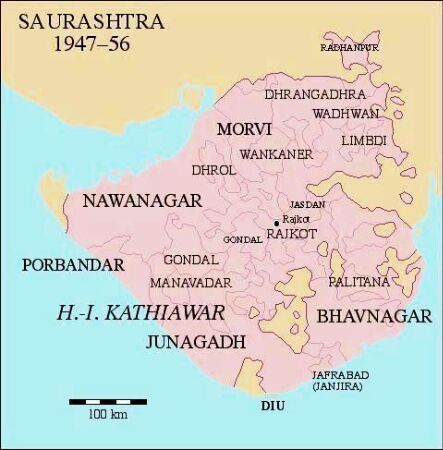Pooling of sovereignties
Geographically fragmented regions of Kathiawar opted to be merged into a united state which would be called Saurashtra

The peninsula of Saurashtra, situated at the northern end of the country's western seaboard, comprised the 14 salute states of Junagadh, Nawanagar, Bhavnagar, Dhrangadhra, Porbandar, Morvi, Gondal, Jafrabad, Wankaner, Palitana, Dhrol, Limbdi, Rajkot and Wadhwan besides 17
non-salute states, and another 191 small states exercising varying degrees of jurisdiction. The area was a little over 22,000 square miles with a population of nearly four million.
However, this does not reflect the actual picture on the ground which is best captured by this quote from The Tribune (July 1939): "As many as 46 states have an area of two or less than two miles. Eight of them, namely Bodanoness, Gandhol, Morchopra, Panchabda, Samadhiala, Chabbadia, Sanala, Satanomess and Vangadhra are just over half a mile each. Yet, none of these is the smallest state in Kathiawar. That distinction goes to Vajanoness which has an area of 0.29 square mile, a population of just above 200, and an annual income of Rs 500."
The administration was further complicated by the fact that many of them had 'enclaves' outside their individual boundaries, with states like Nawanagar, Gondal and Junagadh having nine, 18 and 24 separate areas of territory. The Department of States calculated that the map of Kathiawar could be divided into 860 different jurisdictions. Not only was the internal trade hampered, but also the smugglers and anti-social elements could easily slip into other jurisdictions to circumvent the law. Four years before the Transfer of Power under the attachment scheme, the Political Department had joined the very small states with their neighbours. But, after the lapse of Paramountcy and the Indian Independence Act, in a fairly irresponsible step, the Political Department retroceded the Crown jurisdiction, even over the railway lands. The States Department moved post-haste and appointed MN Buch as the Regional Commissioner of Kathiawar. He began exercising all the powers which the Crown's representative had in the past.
Reference must be made here about the strength of the Kathiawar Rajakeeya Parishad (KRP) which was not only active on the political and social fronts but, thanks to the close association with both Gandhi ji and Sardar Patel, was also organized and disciplined.
Following the transfer of power, there was a wave of agitation all over the Kathiawar for a responsible government, and the states really did not have the wherewithal to manage the law-and-order situation, which was aggravated by partition-related events, especially the influx of refugees from Sindh and Junagadh imbroglio. Moreover, unlike in the past, when popular movements were put down with the assistance of the British, now the KRP had support from across the country, especially the Congress workers in the neighbouring districts. However, the States Department was clear that in the long run, the only option was a responsible government; though there were three distinct views on how this should pan out.
One option — in fact, the easiest — was to merge all the states, both jurisdictional and non-jurisdictional, with the neighbouring province of Bombay. Another option was to limit the attachment to the smaller (non-jurisdictional) states only, and encourage the four prominent ones – Bhavnagar, Nawanagar, Junagadh and Dhrangadhra – to act as 'magnet states'. Even this would not have ensured the establishment of a modern ad-ministration with separate legislatures, executive and judiciary for each of the four units. Hence, the option of organizing all the Kathiawar states into one unit gained currency as, for historical reasons also, the entire region had been identified as Saurashtra.
The first step in this direction was taken on January 15, 1948, when Sardar inaugurated the transition of power from the ruler of Bhavnagar in the presence of UN Dhebar, Balwant Rai Mehta and VP Menon. Later he addressed all the Kathiawar rulers at Rajkot where he hinted that "while little pools of water tend to become stagnant and useless, but that if they were joined together to form a big lake, the atmosphere is cooled, and there is universal benefit." In a subsequent meeting with Menon, the States Ministry made its view quite clear: "It is not possible for the 222 states of Kathiawar to continue their separate existence under modern conditions for much longer. The extinction of separate states may not be palatable, but unless something is done in good time to stabilise the situation in Kathiawar, the march of events may bring about more unpalatable results". One may therefore say that even as the States Ministry was quite clear about what it wanted, it was trying to build a consensus on this issue, and the name of Mahatma was also liberally invoked.
Within the next two days, the Maharaja of Dhrangadhra came out in open support of the Kathiawar union, and the Jam Saheb of Nawanagar was quietly told to acquiesce and become the Rajpramukh of the proposed union or face the consequences of merger with Bombay. Jam Saheb Maharaja Digvijay Sinhji, the nephew of the famous cricketer Ranjitsinhji, seized the opportunity and addressed all the Kathiawar princes highlighting the need to preserve the identity of Kathiawar. As the ruler of Junagadh had already fled to Pakistan, the popular mood after the plebiscite was to join the Kathiawar Union.
The inauguration of the United States of Kathiawar was done by Sardar on February 15, 1948. In his speech, Jam Saheb said "it is not as if we were tired monarchs who were fanned to rest, or bullied into submission. We have by our own volition pooled our sovereignties and covenanted to create this new state — the United States of Kathiawar so that the unity of India is more fully achieved."
In January 1950, before the adoption of the Indian Constitution, it was decided that the Union would be called Saurashtra; and that the Constituent Assembly of Saurashtra, together with the Rajpramukh (Jam Saheb), should form the interim legislature of the state.
Views expressed are personal



